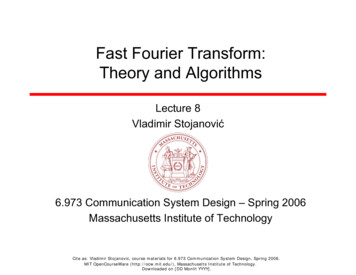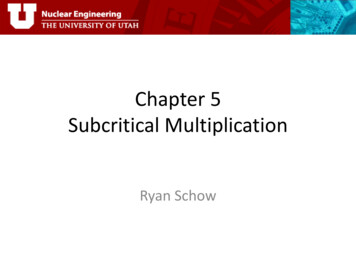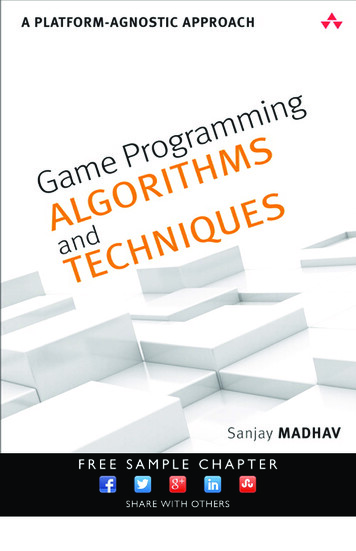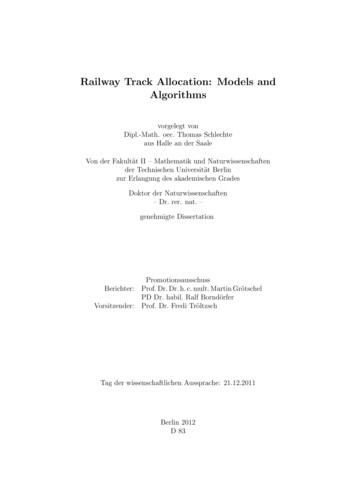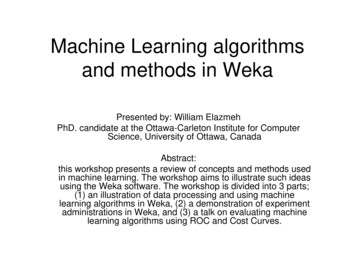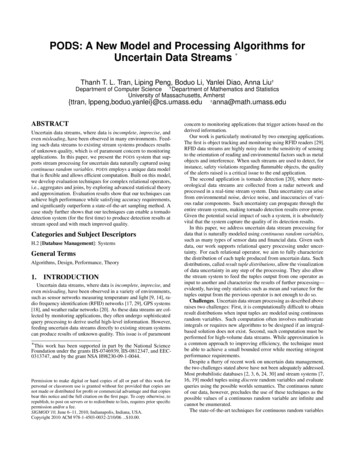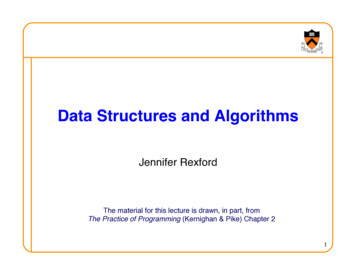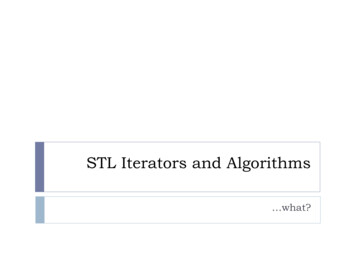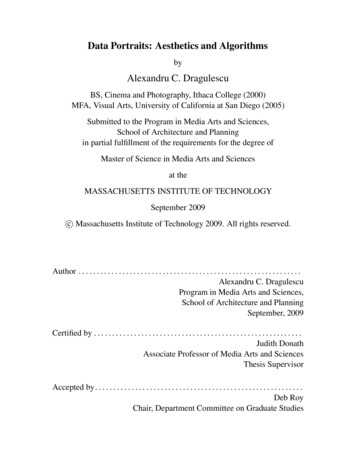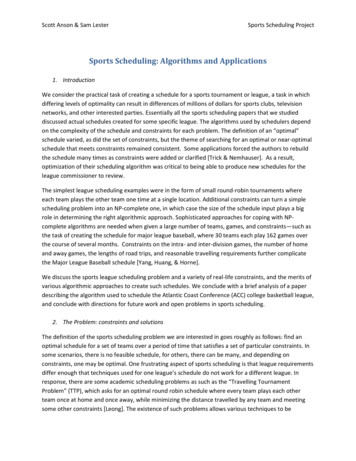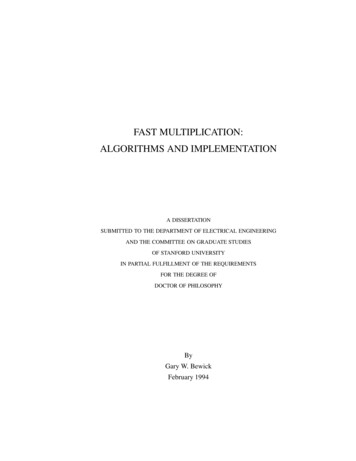
Transcription
FAST MULTIPLICATION:ALGORITHMS AND IMPLEMENTATIONA DISSERTATIONSUBMITTED TO THE DEPARTMENT OF ELECTRICAL ENGINEERINGAND THE COMMITTEE ON GRADUATE STUDIESOF STANFORD UNIVERSITYIN PARTIAL FULFILLMENT OF THE REQUIREMENTSFOR THE DEGREE OFDOCTOR OF PHILOSOPHYByGary W. BewickFebruary 1994
c Copyright 1994 by Gary W. BewickAll Rights Reservedii
I certify that I have read this dissertation and that in myopinion it is fully adequate, in scope and in quality, as adissertation for the degree of Doctor of Philosophy.Michael J. Flynn(Principal Adviser)I certify that I have read this dissertation and that in myopinion it is fully adequate, in scope and in quality, as adissertation for the degree of Doctor of Philosophy.Mark A. HorowitzI certify that I have read this dissertation and that in myopinion it is fully adequate, in scope and in quality, as adissertation for the degree of Doctor of Philosophy.Constance J. Chang-HasnainApproved for the University Committee on Graduate Studies:iii
AbstractThis thesis investigates methods of implementing binary multiplication with the smallestpossible latency. The principle area of concentration is on multipliers with lengths of 53bits, which makes the results suitable for IEEE-754 double precision multiplication.Low latency demands high performance circuitry, and small physical size to limit propagation delays. VLSI implementations are the only available means for meeting these tworequirements, but efficient algorithms are also crucial. An extension to Booth’s algorithmfor multiplication (redundant Booth) has been developed, which represents partial productsin a partially redundant form. This redundant representation can reduce or eliminate thetime required to produce "hard" multiples (multiples that require a carry propagate addition) required by the traditional higher order Booth algorithms. This extension reduces thearea and power requirements of fully parallel implementations, but is also as fast as anymultiplication method yet reported.In order to evaluate various multiplication algorithms, a software tool has been developed which automates the layout and optimization of parallel multiplier trees. The tooltakes into consideration wire and asymmetric input delays, as well as gate delays, as the treeis built. The tool is used to design multipliers based upon various algorithms, using bothBooth encoded, non-Booth encoded and the new extended Booth algorithms. The designsare then compared on the basis of delay, power, and area.For maximum speed, the designs are based upon a 0:6 BiCMOS process using emittercoupled logic (ECL). The algorithms developed in this thesis make possible 53x53 multipliers with a latency of less than 2.6 nanoseconds @ 10.5 Watts and a layout area of13mm2. Smaller and lower power designs are also possible, as illustrated by an examplewith a latency of 3.6 nanoseconds @ 5.8 W, and an area of 8:9mm2. The conclusions basediv
upon ECL designs are extended where possible to other technologies (CMOS).Crucial to the performance of multipliers are high speed carry propagate adders. Anumber of high speed adder designs have been developed, and the algorithms and designof these adders are discussed.The implementations developed for this study indicate that traditional Booth encodedmultipliers are superior in layout area, power, and delay to non-Booth encoded multipliers.Redundant Booth encoding further reduces the area and power requirements. Finally, onlyhalf of the total multiplier delay was found to be due to the summation of the partialproducts. The remaining delay was due to wires and carry propagate adder delays.v
AcknowledgementsThe work presented in this thesis would not have been possible without the assistance andcooperation of many people and organizations. I would like to thank the people at PhilipsResearch Laboratories - Sunnyvale, especially Peter Baltus and Uzi Bar-Gadda for theirassistance and support during my early years here at Stanford. I am also grateful to thepeople at Sun Microsystems Inc., specifically George Taylor, Mark Santoro and the entireP200 gang. I would like to extend thanks to the members of my committee, ConstanceChang-Hasnain, Giovanni De Micheli and Mark Horowitz for their time and patience.Mark, in particular, provided many helpful suggestions for this thesis.Finally I would like to thank my advisor, colleague, and friend Michael Flynn forproviding guidance and keeping me on track, but also allowing me the freedom to pursueareas in my own way and at my own pace. Mike was always there when I needed someoneto bounce ideas off of, or needed support, or requested guidance. My years at Stanfordwere hard work, sometimes frustrating, but I always had fun.The work presented in this thesis was supported by NSF under contract MIP88-22961.vi
1.12Technology Options : : : : : : : : : : : : : : : : : : : : : : : : : : : :11.1.1CMOS : : : : : : : : : : : : : : : : : : : : : : : : : : : : : : :21.1.2ECL : : : : : : : : : : : : : : : : : : : : : : : : : : : : : : : :31.2Technology Choice: : : : : : : : : : : : : : : : : : : : : : : : : : : :51.3Multiplication Architectures : : : : : : : : : : : : : : : : : : : : : : : :51.3.1Iterative : : : : : : : : : : : : : : : : : : : : : : : : : : : : : :51.3.2Linear Arrays : : : : : : : : : : : : : : : : : : : : : : : : : : :61.3.3Parallel Addition (Trees) : : : : : : : : : : : : : : : : : : : : : :61.3.4Wallace Trees : : : : : : : : : : : : : : : : : : : : : : : : : : :81.4Architectural Choices : : : : : : : : : : : : : : : : : : : : : : : : : : :91.5Thesis Structure : : : : : : : : : : : : : : : : : : : : : : : : : : : : : :11Generating Partial Products2.12.213Background : : : : : : : : : : : : : : : : : : : : : : : : : : : : : : : :142.1.1Dot Diagrams : : : : : : : : : : : : : : : : : : : : : : : : : : :142.1.2Booth’s Algorithm : : : : : : : : : : : : : : : : : : : : : : : : :162.1.3Booth 3 : : : : : : : : : : : : : : : : : : : : : : : : : : : : : :182.1.4Booth 4 and Higher : : : : : : : : : : : : : : : : : : : : : : : :20Redundant Booth : : : : : : : : : : : : : : : : : : : : : : : : : : : : :22vii
2.332.2.1Booth 3 with Fully Redundant Partial Products : : : : : : : : : :222.2.2Booth 3 with Partially Redundant Partial Products : : : : : : : :242.2.3Booth with Bias : : : : : : : : : : : : : : : : : : : : : : : : : :272.2.4Redundant Booth 3 : : : : : : : : : : : : : : : : : : : : : : : :322.2.5Redundant Booth 4 : : : : : : : : : : : : : : : : : : : : : : : :332.2.6Choosing the Adder Length : : : : : : : : : : : : : : : : : : : :39Summary : : : : : : : : : : : : : : : : : : : : : : : : : : : : : : : : : :40Adders for Multiplication3.1Definitions and Terminology : : : : : : : : : : : : : : : : : : : : : : : :41Positive and Negative Logic : : : : : : : : : : : : : : : : : : : :43Design Example - 64 bit CLA adder : : : : : : : : : : : : : : : : : : : :443.2.1Group Logic : : : : : : : : : : : : : : : : : : : : : : : : : : : :443.2.2Carry Lookahead Logic : : : : : : : : : : : : : : : : : : : : : :483.2.3Remarks on CLA Example : : : : : : : : : : : : : : : : : : : :51Design Example - 64 Bit Modified Ling Adder : : : : : : : : : : : : : :513.3.1Group Logic : : : : : : : : : : : : : : : : : : : : : : : : : : : :543.3.2Lookahead Logic : : : : : : : : : : : : : : : : : : : : : : : : :553.3.3Producing the Final Sum : : : : : : : : : : : : : : : : : : : : : :593.3.4Remarks on Ling Example : : : : : : : : : : : : : : : : : : : : :60Multiple Generation for Multipliers : : : : : : : : : : : : : : : : : : : :603.4.1Multiply by 3 : : : : : : : : : : : : : : : : : : : : : : : : : : :613.4.2Short Multiples for Multipliers : : : : : : : : : : : : : : : : : :623.4.3Remarks on Multiple Generation : : : : : : : : : : : : : : : : :67Summary : : : : : : : : : : : : : : : : : : : : : : : : : : : : : : : : : :673.1.13.23.33.43.5441Implementing Multipliers684.1Overview : : : : : : : : : : : : : : : : : : : : : : : : : : : : : : : : :684.2Delay Model : : : : : : : : : : : : : : : : : : : : : : : : : : : : : : : :704.3Placement methodology : : : : : : : : : : : : : : : : : : : : : : : : : :714.3.1Partial Product Generator : : : : : : : : : : : : : : : : : : : : :714.3.2Placing the CSAs : : : : : : : : : : : : : : : : : : : : : : : : :80viii
54.3.3Tree Folding : : : : : : : : : : : : : : : : : : : : : : : : : : : :864.3.4Optimizations : : : : : : : : : : : : : : : : : : : : : : : : : : :894.4Verification and Simulation : : : : : : : : : : : : : : : : : : : : : : : :944.5Summary : : : : : : : : : : : : : : : : : : : : : : : : : : : : : : : : : :95Exploring the Design Space5.1Technology: : : : : : : : : : : : : : : : : : : : : : : : : : : : : : : :975.2High Performance Multiplier Structure : : : : : : : : : : : : : : : : : :995.35.2.1Criteria in Evaluating Multipliers : : : : : : : : : : : : : : : : : 1075.2.2Test Configurations : : : : : : : : : : : : : : : : : : : : : : : : 107Which Algorithm? : : : : : : : : : : : : : : : : : : : : : : : : : : : : : 1095.3.1Conventional Algorithms : : : : : : : : : : : : : : : : : : : : : 1095.3.2Partially Redundant Booth : : : : : : : : : : : : : : : : : : : : : 1175.3.3Improved Booth 3 : : : : : : : : : : : : : : : : : : : : : : : : : 1245.4Comparing the Algorithms : : : : : : : : : : : : : : : : : : : : : : : : : 1255.5Fabrication : : : : : : : : : : : : : : : : : : : : : : : : : : : : : : : : : 1255.5.1696Fabrication Results : : : : : : : : : : : : : : : : : : : : : : : : 1295.6Comparison with Other Implementations : : : : : : : : : : : : : : : : : 1295.7Improvements : : : : : : : : : : : : : : : : : : : : : : : : : : : : : : : 1325.8Delay and Wires : : : : : : : : : : : : : : : : : : : : : : : : : : : : : : 1335.9Summary : : : : : : : : : : : : : : : : : : : : : : : : : : : : : : : : : : 134Conclusions135A Sign Extension in Booth Multipliers138A.1 Sign Extension for Unsigned Multiplication : : : : : : : : : : : : : : : : 138A.1.1Reducing the Height : : : : : : : : : : : : : : : : : : : : : : : : 140A.2 Signed Multiplication : : : : : : : : : : : : : : : : : : : : : : : : : : : 142B Efficient Sticky Bit Computation144B.1 Rounding : : : : : : : : : : : : : : : : : : : : : : : : : : : : : : : : : 144B.2 What’s a Sticky Bit? : : : : : : : : : : : : : : : : : : : : : : : : : : : : 145ix
B.3 Ways of Computing the Sticky : : : : : : : : : : : : : : : : : : : : : : : 145B.4 An Improved Method : : : : : : : : : : : : : : : : : : : : : : : : : : : 146B.5 The -1 Constant : : : : : : : : : : : : : : : : : : : : : : : : : : : : : : 149C Negative Logic Adders150Bibliography152x
List of Tables5.1BiCMOS Process Parameters : : : : : : : : : : : : : : : : : : : : : : :5.2106 Bit Carry Propagate Adder Parameters : : : : : : : : : : : : : : : : 1075.3Delay/Area/Power of Conventional Multipliers : : : : : : : : : : : : : : 1105.4Delay/Area/Power of 55 Bit Multiple Generator : : : : : : : : : : : : : : 1175.5Delay/Area/Power of Redundant Booth 3 Multipliers : : : : : : : : : : : 1195.6Delay/Area/Power of Redundant Booth 3 Multipliers (continued) : : : : : 1205.7Improved Booth 3 - Partial Product Bit Delays : : : : : : : : : : : : : : 1245.8Multiplier Designs : : : : : : : : : : : : : : : : : : : : : : : : : : : : : 132xi98
List of Figures1.1BiCMOS (BiNMOS) buffer. : : : : : : : : : : : : : : : : : : : : : : : :31.2ECL inverter. : : : : : : : : : : : : : : : : : : : : : : : : : : : : : : : :41.3Simple iterative multiplier. : : : : : : : : : : : : : : : : : : : : : : : : :61.4Linear array multiplier. : : : : : : : : : : : : : : : : : : : : : : : : : : :71.5Adding 8 partial products in parallel. : : : : : : : : : : : : : : : : : : :71.6Reducing 3 operands to 2 using CSAs. : : : : : : : : : : : : : : : : : : :81.7Reduction of 8 partial products with 4-2 counters. : : : : : : : : : : : : :102.116 bit simple multiplication. : : : : : : : : : : : : : : : : : : : : : : : :142.216 bit simple multiplication example. : : : : : : : : : : : : : : : : : : :152.3Partial product selection logic for simple multiplication. : : : : : : : : : :162.416 bit Booth 2 multiply. : : : : : : : : : : : : : : : : : : : : : : : : : :172.516 bit Booth 2 example. : : : : : : : : : : : : : : : : : : : : : : : : : :182.616 bit Booth 2 partial product selector logic. : : : : : : : : : : : : : : : :192.716 bit Booth 3 multiply. : : : : : : : : : : : : : : : : : : : : : : : : : :192.816 bit Booth 3 example. : : : : : : : : : : : : : : : : : : : : : : : : : :202.916 bit Booth 3 partial product selector logic. : : : : : : : : : : : : : : : :212.10 Booth 4 partial product selection table. : : : : : : : : : : : : : : : : : :212.11 16 x 16 Booth 3 multiply with fully redundant partial products. : : : : : :232.12 16 bit fully redundant Booth 3 example. : : : : : : : : : : : : : : : : : :232.13 Computing 3M in a partially redundant form. : : : : : : : : : : : : : : :252.14 Negating a number in partially redundant form. : : : : : : : : : : : : : :262.15 Booth 3 with bias. : : : : : : : : : : : : : : : : : : : : : : : : : : : : :272.16 Transforming the simple redundant form. : : : : : : : : : : : : : : : : :28xii
2.17 Summing K , Multiple and Z. : : : : : : : : : : : : : : : : : : : : : : :292.18 Producing K 3M in partially redundant form. : : : : : : : : : : : : : :312.19 Producing other multiples. : : : : : : : : : : : : : : : : : : : : : : : : :322.20 16 x 16 redundant Booth 3. : : : : : : : : : : : : : : : : : : : : : : : :332.21 16 bit partially redundant Booth 3 multiply. : : : : : : : : : : : : : : : :342.22 Partial product selector for redundant Booth 3. : : : : : : : : : : : : : :352.23 Producing K 6M from K 3M ? : : : : : : : : : : : : : : : : : : : :362.24 A different bias constant for 6M and 3M. : : : : : : : : : : : : : : : : :382.25 Redundant Booth 3 with 6 bit adders. : : : : : : : : : : : : : : : : : : :393.1Carry lookahead addition overview. : : : : : : : :
The algorithms developed in this thesis make possible 53x53 mul- tipliers with a latency of less than 2.6 nanoseconds @ 10.5 Watts and a layout area of 13mm2. Smaller and lower power designs are also possible, as illustrated by an example with a latency of 3.6
